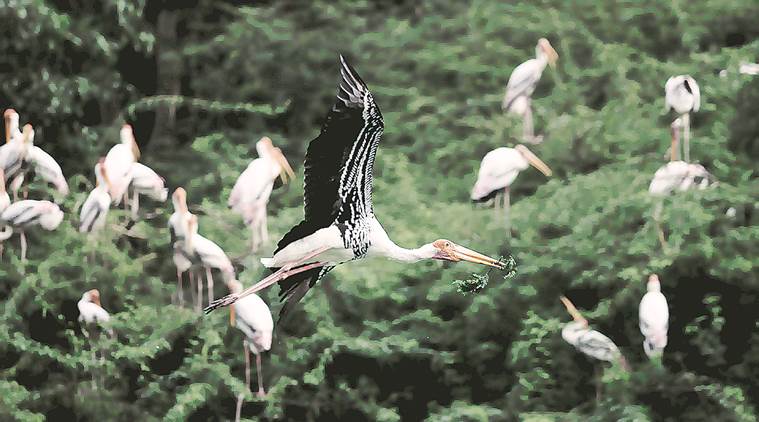 The storks have been nesting at Delhi zoo since 1960. (Express Archive)
The storks have been nesting at Delhi zoo since 1960. (Express Archive)
Even as visitors thronged the enclosures of the Royal Bengal tigers and the Reptile House at the National Zoological Park late Tuesday afternoon, further away a batch of more than 30 painted storks hovered over mesquite trees next to the pond — home to ducks, white storks, and herons. The guests have arrived early this year.
“Painted storks usually come to the zoo by mid or late August, sometimes even September with the sole purpose of nesting… but this time an advanced party arrived a week ago. By September, we expect over 800 painted storks as they migrate from the Himalayas,” said zoo curator Riaz Khan.
As per a research paper called ‘foraging behaviour and prey size of the painted stork’, co-authored by Abdul J Urfi, associate professor at Delhi University’s Department of Environmental Studies, “the painted stork is commonly found in Delhi… occurring singly or in small groups throughout the year, and in August–September, they start congregating at traditional nesting colonies such as the National Zoological Park”.
As per the research paper, the painted storks have been regularly nesting at the Delhi zoo since 1960, and are exclusively piscivorous (feeding on fish). At the zoo, their long yellow beaks, white and black feathers and a touch of pink on the tails make them stand out; and a few visitors try to capture the image on their phones. As they fly over the pond, their wings sound like propellers.
“They stay here till March, lay eggs… every year 800-plus baby painted storks take birth at the zoo. The adults fly away by early March, and then the children follow by March-end,” said Khan. Preparations have been going on at the Delhi zoo for over two months in anticipation of local migratory birds — the pond is filled up to the brim and has been desilted, while disinfectants are being sprayed to avoid a recap of 2016 when casualties happened due to bird flu.
As per the research paper, “they were first observed breeding in Sultanpur in 1993… thereafter, their nesting here was sporadic, until around 2000, after which it occurred annually… painted storks congregate at Sultanpur only during the nesting season, and they are absent from this site during the rest of the year. A similar pattern has been observed at Delhi zoo and the Keoladeo Ghana National Park in Bharatpur”.